
1
TAÏP CHÍ KHOA HOÏC VAØ COÂNG NGHEÄ ÑAÏI HOÏC COÂNG NGHEÄ ÑOÀNG NAI
Số: 03-2024
ENHANCING CASCADE RESERVOIR DISPATCHING WITH
IMPROVED KIDNEY ALGORITHM
Nguyen Trong The1, Nguyen Van Quyet2, Ngo Truong Giang3*, Dao Thi Kien4
1University of Information Technology, VNU-HCM
2Dong Nai University of Technology
3Thuy Loi University
4School of Computer Science and Mathematics, Fujian University of Technology
*Corresponding author: Ngo Truong Giang, giangnt@tlu.edu.vn
1. INTRODUCTION
Cascade reservoir systems play a vital role
in water resource management and power
generation, particularly in regions with
significant hydroelectric potential (Fan et al.,
2015). The optimal scheduling of cascade
reservoirs is a complex and challenging
problem (He et al., 2019) due to the nonlinearity
of the system, multiple operational constraints,
and the need to balance water release for power
generation, irrigation, flood control, and
environmental preservation (Bai et al., 2017).
Traditional optimization methods such as
linear, non-linear, network flow, and dynamic
programming often encounter difficulties in
efficiently solving the large-scale, multi-
objective optimization problem (Dao et al.,
2022) associated with cascade reservoir
dispatching (T. Wang et al., 2023).
In recent years, heuristic optimization
algorithms have gained attention for their
ability to address complex optimization
problems (Sun et al., 2018). However, existing
algorithms, including the standard Kidney
Algorithm (KA)(Jaddi et al., 2017), have
limitations such as low population vitality, slow
convergence speed, and premature
convergence, which hinder their effectiveness
in solving the cascade reservoir dispatching
problem. The KA is a heuristic optimization
algorithm inspired by the physiological
function of kidneys in the human body. It
GENERAL INFORMATION
ABSTRACT
Received date: 01/02/2024
Addressing the intricate optimization challenge of cascade
reservoir dispatching, this paper introduces a novel Improved
Kidney Algorithm (IKA) to overcome the limitations of
traditional and heuristic methods. Traditional optimization
approaches often exhibit slow convergence and high
computational costs, while natural heuristic algorithms can
suffer from premature convergence and suboptimal solutions.
To improve the optimization effectiveness, the IKA combines
a migration strategy with an initial solution of the scaling
factor and an adaptive parameter adjustment mechanism. Its
application to the long-term power generation scheduling of a
cascade reservoir demonstrates significant improvements in
multi-year average power generation and reduction of
discarded water, substantiating its potential for addressing
complex optimization problems.
Revised date: 22/02/2024
Accepted date: 17/04/2024
KEYWORD
Cascade reservoirs dispatching;
Improved Kidney Algorithm;
Optimization;
Heuristic algorithm.

TAÏP CHÍ KHOA HOÏC VAØ COÂNG NGHEÄ ÑAÏI HOÏC COÂNG NGHEÄ ÑOÀNG NAI
2
Số: 03-2024
simulates the process of blood filtration and
reabsorption in the kidneys to develop an
efficient and effective optimization algorithm
for solving complex optimization problems
(Ehteram et al., 2018). The algorithm is
designed to maintain population diversity,
adaptability, and vitality, drawing analogies
from the biological processes of filtration,
reabsorption, and excretion in the human
kidneys (Ekinci & Hekimoğlu, 2019).
Due to the drawbacks of the standard KA
algorithm such as slow convergence speed, low
population vitality, and premature
convergence, this research suggests an
Improved Kidney Algorithm (IKA) that
incorporates a migration strategy with a scaling
factor and an adaptive parameter adjustment
strategy (Ehteram et al., 2018). The IKA is then
employed to solve the optimal scheduling of a
cascade reservoir (Y. Wang et al., 2020) for
long-term power generation to showcase its
viability and efficiency.
The main goals of this study are outlined as
follows: This paper offers a comprehensive
explanation of the optimization principle of the
standard KA algorithm. It presents an IKA that
tackles the deficiencies of the standard
algorithm, improving population diversity and
convergence speed. The IKA is utilized to
address the optimal scheduling of long-term
power generation in a cascade reservoir,
demonstrating its effectiveness in enhancing
multi-year average power generation and
decreasing discarded water. By addressing
these objectives, this research aims to
contribute to the optimization of cascade
reservoir dispatching and highlight the potential
of the IKA in addressing complex optimization
problems in water resource management and
power generation. The subsequent sections of
this paper will delve into the background and
related work, the optimization principle of the
standard KA algorithm, the strategies of the
IKA, its application in cascade reservoir
dispatching, and conclude with potential future
research directions.
2. BACKGROUND AND RELATED
WORK
Cascade Reservoir Dispatching
Cascade reservoir systems are essential for
managing water resources and generating
hydropower in regions with abundant water
sources (Thaeer Hammid et al., 2020). These
systems consist of multiple interconnected
reservoirs, each serving various purposes such
as flood control, irrigation, and power
generation (Dao, Nguyen, Do, et al., 2023). The
optimal scheduling of cascade reservoirs
involves determining the release policies for
each reservoir over an extended time horizon to
meet multiple objectives while adhering to
operational constraints (Suwal et al., 2020). The
illustration in Figure 1 depicts a cascade
reservoir system that is connected to the
management of water resources and the
production of hydropower, and it has ample
water sources.
Figure 1. An example of a cascade reservoir
system with abundant water sources is related
to managing water resources and generating
hydropower.
The complexity of cascade reservoir
dispatching arises from the need to balance
conflicting objectives, such as maximizing
power generation (Asfaw & Saiedi, 2011),
ensuring water supply for irrigation (Chen et
al., 2021), and maintaining ecological flow,
while considering uncertainties in inflow,
energy prices, and environmental regulations

3
TAÏP CHÍ KHOA HOÏC VAØ COÂNG NGHEÄ ÑAÏI HOÏC COÂNG NGHEÄ ÑOÀNG NAI
Số: 03-2024
(Lai et al., 2022). Traditional optimization
methods, including linear programming and
dynamic programming, face challenges in
efficiently solving the large-scale, multi-
objective, and non-linear optimization problem
associated with cascade reservoir dispatching.
In the long-term power generation dispatch
model of cascade reservoirs, the best way to use
them is to use their hydrology and storage
capacity to make up for differences between
upstream and downstream reservoirs (Dao,
Nguyen, Do, et al., 2023). This study’s cascade
reservoir power generation dispatching model
aims to achieve the maximum multi-year
average power generation with guaranteed
output. According to the upstream water inflow
and the water in each section during the
dispatch period, various operation constraints
and boundary conditions are considered, and
the cascade reservoirs are optimized by
optimizing each cascade reservoir. To
maximize the power generation capacity of the
cascade reservoirs to satisfy the guaranteed
output of the cascade as much as possible
(Yazdi & Moridi, 2018). The objective function
is formulated for the generation dispatch model
of cascade reservoirs. Let G represent the
objective function for the optimal dispatch of
cascade reservoirs. The maximum average
outputs of G is computed as the objective
function for the optimal dispatch problem of
cascade reservoirs, expressed as follows.
𝑚𝑎𝑥𝐺 =1
𝑁∑⍙𝑇(𝑡)∗
𝑇
𝑡=1
(∑𝑃(𝑚,𝑡)−𝐶𝜑(𝑃𝑓−∑𝑃(𝑚,𝑡)
𝑀
𝑚=1 )𝑎
𝑀
𝑚=1 ),
(1)
where 𝐺 is is the average output amount of
flowing (e.g., volume flowing water in or out of
reservoirs); 𝑡 and T are the time and total
period time number (e.g., 12 month of period
year cycle); ∆𝑇 (𝑡) and N are calculated period
(it is calculated, e.g., hours, day, or month) and
year number during the dispatch period,
respectively; 𝑚 and 𝑀 are reservoir numbers
and the total number of reservoirs respectively;
C, φ, and 𝑎 are the penalty coefficients for the
setting variables of guaranteed outputs, which
are all non-negative variables. The objective
function of the optimization is subject to
constraints that need to be met, including both
equality and inequality constraints. The
constraints consist of both equality and
inequality constraints, such as Eqs. 2 to 8, that
must be satisfied as follows. A coefficient of φ
is calculated as follows.
𝜑={0, ∑𝑃(𝑚,𝑡)≥𝑃𝑓
𝑀
𝑖=1
1, ∑𝑃(𝑚,𝑡)<𝑃𝑓
𝑀
𝑖=1 , (2)
where 𝑃(𝑚,𝑡) is the average output of the m-th
reservoir during 𝑡 period; 𝑃𝑓 is the guaranteed
output of cascade reservoirs.
The equation constraints are the water
balance equation, the hydraulic connection
equation, and the boundary conditions; the
inequality constraints are all non-negative
constraints on power output, outgoing flow,
water level (or storage capacity) and variables.
The relevant mathematical expressions are as
follows: water balance equation, hydraulic
connection equation, boundary conditions,
power output constraint, outbound flow
restriction, and water level operation
constraints. The water balance is calculated as
follows:
𝑉(𝑚,𝑡+1)=𝑉(𝑚,𝑡)+[𝑄𝑖𝑛(𝑚,𝑡)−
𝑄𝑜𝑢𝑡(𝑚,𝑡)−𝐿(𝑚,𝑡)]∗∆𝑇(𝑡), (3)
where 𝑉(𝑚,𝑡) and 𝑉(𝑚,𝑡+1) are the average
storage of the m-th reservoir during t and t+1
respectively; Qin (m, t), Qout (m, t) and L (m, t)
are the average inflow, outflow, and loss flow
including evaporation and seepage of the mth
reservoir during t period, respectively. The
hydraulic connection is computed as follows.
𝑄𝑖𝑛(𝑚+1,𝑡)=𝑄𝑜𝑢𝑡(𝑚,𝑡)+𝑞(𝑚,𝑡), (4)
where 𝑞(𝑚,𝑡) is the average inflow between
the m-th reservoir and the m+1th reservoir
during t period. The initial water level is set by
the boundary conditions as follows:
𝑍(𝑚,1)=𝑍𝑏(𝑚), 𝑍(𝑚,𝑇+1)=𝑍𝑒(𝑚), (5)

TAÏP CHÍ KHOA HOÏC VAØ COÂNG NGHEÄ ÑAÏI HOÏC COÂNG NGHEÄ ÑOÀNG NAI
4
Số: 03-2024
where 𝑍(𝑚,1) and 𝑍(𝑚,𝑇 + 1) are the initial
water level [𝑍𝑏(𝑚)] and the end water level
[𝑍𝑒(𝑚)] of the m-th reservoir operation. The
inequality constraints are all non-negative
constraints, as follows: Power output
constraints:
𝑃𝑚𝑖𝑛(𝑚,𝑡)≤𝑃(𝑚,𝑡)≤𝑃𝑚𝑎𝑥(𝑚,𝑡), (6)
where 𝑃𝑚𝑖𝑛(𝑚,𝑡) and 𝑃𝑚𝑎𝑥(𝑚,𝑡) are the lower
and upper limits of the average output of the m-
th reservoir during t period. The outbound flow
restriction is set as follows.
𝑄𝑜𝑚𝑖𝑛(𝑚,𝑡)≤𝑄𝑜𝑢𝑡(𝑚,𝑡)≤𝑄𝑜𝑚𝑎𝑥(𝑚,𝑡), (7)
where 𝑄𝑜𝑚𝑖𝑛(𝑚,𝑡) and 𝑄𝑜𝑚𝑎𝑥(𝑚,𝑡) are the
lower and upper limits of the m-th reservoir’s
discharge flow during t period. The water level
operation constraint is set under the following
equation:
𝑍𝑚𝑖𝑛(𝑚,𝑡)≤𝑍(𝑚,𝑡)≤𝑍𝑚𝑎𝑥(𝑚,𝑡), (8)
where 𝑍𝑚𝑖𝑛(𝑚,𝑡) and 𝑍𝑚𝑎𝑥(𝑚,𝑡) are the lower
limit and upper limit of the water level during t
period of the mth reservoir, respectively.
3. IMPROVED KIDNEY ALGORITHM
Before going into more detail about
proposing an Improved Kidney Algorithm
(IKA) with strategies such as adaptive filtration
threshold mechanisms and diversity
maintenance, we will review the KA algorithm
and its optimization principle.
3.1 The Kidney Algorithm and its
Optimization Principle
The KA was introduced by Jaddi in 2017
(Jaddi et al., 2017) as a natural heuristic
optimization algorithm inspired by the
physiological mechanism of the human kidney,
specifically its processes of filtration,
reabsorption, secretion, and excretion of blood
and urine. This algorithm is recognized for its
robustness and strong optimization capabilities,
achieved through minimal parameterization,
including a single filter rate parameter, along
with common heuristic algorithm parameters
such as population size and maximum number
of iterations. The KA’s simplicity and ability to
generate new individuals based on current and
optimal solutions enable excellent global search
capabilities. The optimization principle of the
KA can be outlined as follows.
Filtration: In this phase, a diverse population of
candidate solutions, referred to as individuals or
"nephrons," is generated and evaluated based
on their fitness concerning the problem
objectives and constraints.
Reabsorption: The algorithm selects the fittest
individuals, akin to the reabsorption of essential
kidney substances, to be retained in the
population for further exploration and
exploitation.
Excretion: Less fit individuals are eliminated
from the population to maintain diversity and
prevent premature convergence, mirroring the
excretion process in the kidneys.
The optimization principle of the KA can be
further summarized as follows:
Step 1 Initialization: The algorithm
initializes a diverse population of candidate
solutions, often represented as a set of
chromosomes or vectors, to form the initial
population of nephrons. The population
initialization starts by randomly initializing a
population of agents, known as population size
Np, within the search space boundaries [𝑈𝑏𝑖,
𝐿𝑏𝑖]. Each bat is assigned a position and a
frequency. Let S be a vector representing the
solution, with consideration as the decision
variable starting at an initial position expressed
as follows.
𝑆𝑖=𝐿𝑏𝑖+𝑟𝑎𝑛𝑑()∙(𝑈𝑏𝑖−𝐿𝑏𝑖), (9)
where 𝑆𝑖 denotes the solute of the individual i
at the current iteration t, which is considered the
candidate solution for the optimal algorithm.;
𝑈𝑏𝑖 and 𝐿𝑏𝑖 are the upper and lower boundaries
of the solution space for a decision variable,
where i is the index of the decision variable, and
𝑟𝑎𝑛𝑑() is a variable random with a value range
∈ [0,1] in the normal distribution.
Step 2- Fitness Evaluation: After the initial
population generated, we calculate the

5
TAÏP CHÍ KHOA HOÏC VAØ COÂNG NGHEÄ ÑAÏI HOÏC COÂNG NGHEÄ ÑOÀNG NAI
Số: 03-2024
objective function values of all individuals in
the population, and use the individual with the
largest objective function value as the currently
discovered optimal solution 𝑆best. Set KA
parameter values, e.g., filter rate parameter α
and maximum number of iterations Imax. Each
individual in the population is evaluated based
on its fitness with respect to the optimization
objectives and constraints, typically involving
assessing its performance in the context of the
specific optimization problem.
Step 3-Filtration: The algorithm selects
individuals from the population based on their
fitness, aiming to maintain a diverse set of
potential solutions for further exploration. For
the i-th iteration (i≥ 1), a new solute
(individual) is generated by simulating the
movement of the current solute individual to the
optimal solution. The calculation formula for
solute transport is as follows:
𝑆𝑖=𝑆𝑖−1 +𝑟𝑎𝑛𝑑()∙(𝑆𝑏𝑒𝑠𝑡 −𝑆𝑖−1), (10)
where 𝑆𝑖−1 and 𝑆𝑖 are the solutes (solutions) in
the i-1th and i-th iterations respectively;
r𝑎𝑛𝑑 () is a uniformly distributed random
number generator. The real number of the
interval. Filtration operation is used to calculate
the filtration rate value 𝑓𝑟 filter the solute in the
population, and the filtered solute will be
divided into blood (FB) and urine liquid (W).
𝑓𝑟=𝛼∙∑𝑓(𝑆𝑗)
𝑁𝑝
𝑗=1
𝑁𝑝, (11)
where 𝑓𝑟 is the filtering rate; 𝑓(𝑆𝑗) is the
objective function value of the j-th solute S in
the population; the filtering parameter α is a real
number located in [0,1].
Step 4-Reabsorption: it is the process in
which the fittest individuals are retained in the
population for subsequent iterations, ensuring a
focus on exploiting the most promising regions
of the search space. The reabsorption operation
calculates the objective function value of all
solutes in the urine stock solution W. Solutes
with larger objective function values will be
reabsorbed by blood FB, and solutes with
smaller objective function values or outsides of
limitation boundaries (𝐹𝐵𝑚𝑎𝑥 and 𝐹𝐵𝑚𝑖𝑛) will
be excreted and go out.
𝐹𝐵(𝑡)=𝐹𝐵𝑚𝑎𝑥 ×𝑓𝑟×cos(𝜋
2×𝑡−1
𝑇𝑚𝑎𝑥)+𝐹𝐵𝑚𝑖𝑛,
(12)
where 𝐹𝐵𝑚𝑎𝑥 and 𝐹𝐵𝑚𝑖𝑛 are maximun and
minimun of the flood flow; Tmax is a maximum
number of iterations; t is current time; 𝐹𝐵 is the
flood flow.
Step 5-Secretion operation: adjustment
with the objective function value of the solute
reabsorbed by FB and the solute in urine. A
secreted solute is calculated as follows.
𝑊(𝑡)=𝑊𝑚𝑎𝑥 ×𝑒𝑥𝑝(ln(𝑊𝑚𝑖𝑛
𝑊𝑚𝑎𝑥)
𝑇𝑚𝑎𝑥 )×𝑡, (13)
where 𝑊max and 𝑊min are the max and min
adjusted ranges, respectively; t is the current
iteration and Tmax is the maximum iteration
number.
Step 6-Excretion operation: For
individuals in the original urine, if they cannot
become individuals in the blood after re-
collection and filtration operations, they will be
excreted. Then, the individuals in the blood are
sorted according to the objective function
value, and the optimal individual Sbest is
updated. Combine blood F solutes (solutions)B
and original urine W, update the filtration rate
value fr, and enter the next iteration: i=i+1. A
generated new solute in the population as a
solution set. The decision variables of the
solution vector is expressed as follows.
𝑆𝑛𝑒𝑤(𝑖)=
{𝑆(𝑖)+𝑟𝑎𝑛𝑑(0,1)×𝑊,𝑖𝑓(𝑟𝑎𝑛𝑑(0,1)<𝐹𝐵)
𝑆(𝑖) 𝑜𝑡ℎ𝑒𝑟𝑤𝑖𝑠𝑒 ,
(14)
where 𝑆𝑛𝑒𝑤 is a new solute (solution)
population, i-th index; 𝑟𝑎𝑛𝑑(0,1) is a random
number arange of ∈[0,1].
Step 7-Iterative Refinement: The algorithm
iteratively performs filtration, reabsorption, and
excretion steps over multiple generations to
improve the quality of solutions and converge



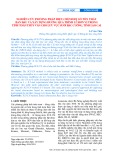



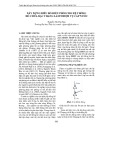
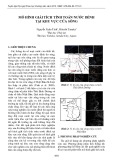
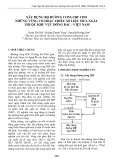











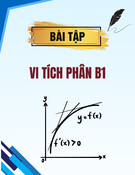



![Quyển ghi Xác suất và Thống kê [chuẩn nhất]](https://cdn.tailieu.vn/images/document/thumbnail/2025/20251030/anh26012006/135x160/68811762164229.jpg)
